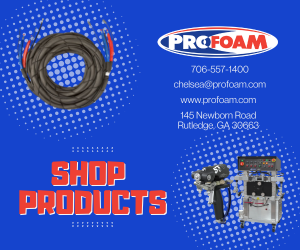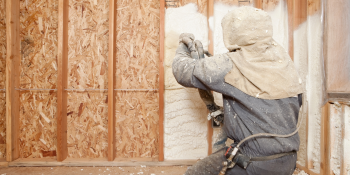Q&A Forums
SPF Installation Question Post New Topic | Post Reply
| Author | Comments |
|---|---|
|
David Hanson
Posted: Feb 27, 2007 05:59 PM
|
SPF Installation Question
We contracted to have our new home insulated with SPF. We encountered some problems with the either the installation or the product. The manufacturer and the installer both were very silent about the issues. It turns out that the installer sprayed the 2 lb. foam too thick in all cavities - so we have "exotherms" where the SPF is clearly bad, and where there is no exotherm, the middle (of 2x4 and 2x6 wall thicknesses) is soft and the outer serface is hard, but we still wind up with a closed cell foam that was installed as an open cell foam that has a significantly reduced R value. Now that we have done our reseach and pointed these issues out to the installer and the manufacturer, the installer wants to "fix" the problem. Given that the SPF encases the wiring and plumbing, I do not see a way to rectify this - as mechanical or chemical removal will likely damage the walls, wiring, and / or plumbing. Does anyone have any suggestions on how this can be rectified, or if they have seen this in the past and how it was dealt with? Thank you for any suggestions. |
|
Thomas Kasper
Posted: Feb 27, 2007 07:55 PM
|
When I went to foam school they trained me to spray 2lb foam in one inch passes. When it is built up in one inch passes and allowed to cool before the next pass you can build it as thick as you want. Your foam might have been installed in one, three inch pass, but I don't necessarily think that is the problem. I think is it a possibility your foam could have been sprayed off ratio with the B side being rich and the A side being restricted. Are you sure it is a 2lb foam? Is it a 1.9 or 1.6 or 1.2? Is the whole house like this or just a couple of wall cavities? Does it look like it is sprayed nice and even or does it have big hills and valleys? |
|
Posted: Feb 27, 2007 08:29 PM
|
Can you elaborate on the "exotherms"? Do you mean there are voids in the foam where there are air pockets instead of foam? What do you mean by "a closed cell foam installed as an open cell foam"? Closed cell foam will have an outer surface called the "skin" which is much harder than the underlying foam (5x more dense). This may contribute your perception of closed vs. open. There should not be any voids in the foam though. But there may be layers of foam with specified density (2#) with a more dense skin, and then another layer of 2# density with a skin over and over until the desired depth is reached. 1-1.5" passes are typical, with 3+ passes needed to fill a stud cavity with closed cell foam. Tim Granite State Spray Foam Co. |
|
David Hanson
Posted: Feb 28, 2007 05:32 AM
|
Tom, Thank you for your reply. I reviewed the material data sheets I was given for the product. The stated density is 2.10 - 2.35 @ 2inches and 1.88-1.99 @ 4 inches. The entire house was to be filled - full cavities. Upon the first completion by the installer all the cavities were 2 or more inches from being full. They told me that was all they could do, so I called the office and they came back to re-apply to fill all cavities. As a result most cavities were over filled and had to be trimmed. None of the spray was even, all of it was big hills and valleys after the first application and after the respraying (minimum 1 inch maximum 4 inch difference between hill top and valley in the walls - in the cathedral ceilings we had them spray 1 inch and I have huge 10 inch mounds in places in the ceiling.) In some cavities where the material was trimmed to level, a very dark discolored material with holes like swiss cheese (1/2 inch) was exposed. I was told these are "exotherms" - where the material became too hot during application. I can put my finger into the material in these areas and the material crumbles and falls out. In some cavities where trimmed, the material is not discolored, and the has holes not as large, but still I can push my finger through the material. There is more resistance, and it does not crumble. Other areas have a shiny "skin" on them and appear to be OK - other than noticable hills and valleys. In one area like this I had to pull out a section of foam to repair a faulty gas line installation so the utility could repair the regulator. The first inch was real tough to get out, but the middle of the foam in this section had holes like the others. |
|
David Hanson
Posted: Feb 28, 2007 06:05 AM
|
Tim, Thank you for your reply. I was told that exotherms are the areas where the foam was applied too thick - resulting in too much heat being generated - so the cell stucture is not correct (looks like swiss cheese) and the material is dark and discolored. The material crumbles easily too. Part of the reseach that we did included taking samples and sending them to a lab for testing. I sent pieces from a section of an exotherm, a section of the not good, but not discolored cavity, and a section from a cavity with a shiny skin. The material data sheets I was given state the closed cell content is greater than 90%. The lab result showed that the foam was not greater than 90% closed cell in the areas with the shiny skin. I received results between 90% and 40% averaging out at 64%. The lab indicated that they could not test the exotherm and other sample. It appears to me that the installer applied the foam in 3 to 5 inch passes - sometimes we see an exotherm, sometimes not, and in the sections where there is no exotherm and the surface appears good, the material is not performing as described. This is what I meant by "a closed cell foam installed as an open cell foam". |
|
Posted: Feb 28, 2007 10:27 AM
|
Wow, where are you? Sounds like you got an inexperienced installer and certainly an inferior installation! Hopefully someone here is local that can help you out! Tim Granite State Spray Foam Co. |
|
David Hanson
Posted: Feb 28, 2007 10:45 AM
|
Tim, I am in the great lakes region. I would agree with your conclusion. I am still trying to figure out what the help would be. The installer wants to fix this issue. I am not sure how that can be done, and the installer will not elaborate on how it will be fixed, just that they will take care of it, and not to worry. Have you ever run across this sort of a situation before? Any suggestions on how it might be handled? Thank you. |
|
Luke Kujacznski
Posted: Feb 28, 2007 11:08 AM
|
I have heard on this before. What should happen is that all the foam should be removed and reinstalled by a experienced person. The cost should be covered by the installer. You might want to look at having a different installer redo the work. Where in the great lakes area are you located? Luke |
|
David Hanson
Posted: Feb 28, 2007 12:47 PM
|
Luke, When the installer trimmed the foam back to the wall (because of overfilling) they used a reciprocating saw. The faces of all of the framing members have saw cuts from the saw. I am assuming that they are going to use the same tool to cut it out of the walls. I am concerned about potential damage to the structure's framing, electrical and plumbing during the removal of the SPF. Has anyone had experience in removing foam from wall cavities? I am considering leaving it in place because I fear the possible damage is worse than problem I now have - assuming the R-value of the exotherm areas meets code requirements. |
|
Luke Kujacznski
Posted: Feb 28, 2007 03:03 PM
|
The way I would take it out would be with the claw of a hammer. You do not need nor would I try and take the foam out with a power tool. He should not have used a sawzall to trim off the excess. I do not want to say bad things about your contractor and I do have to admit this is one area where our( foamers) industry needs to improve. There is no liscensing or required training for foamers, I think there should be. There is such a potential for less then par installation(like yours). This is something that we are working on. If there is anyway I can help let me know. For the good of the industry I want to make this right by you. Bottom line, the foam can be removed without damaging you house any more and more foam can be applied in its place. It can be done, it will not be easy, but that is what needs to happen. Luke Kujacznski 269.217.1612 Eco Foam Insulating Kalamazoo, Mi |
|
David Hanson
Posted: Feb 28, 2007 04:37 PM
|
Luke, Thank you for your candor in this matter. I thought I had selected the correct installers. The foam manufacturer assured me that the installers had to be trained to spray their product, and that the installer was one of the larger customers for the product. I have 2000sf of 2x6 wall and 1200sf of 2x4 wall filled, and the one inch on the roof. By no means will this be easy. They spent one week applying the first time and three days on followups to fill the cavities. I can only guess how long it will take to remove it, then to respray it correctly. I think this is why they wanted to ignore the matter. I appreciate all of the replies. If anyone has any direct experience with a situation like this I would appreciate any insights they are willing to share. |
|
Luke Kujacznski
Posted: Feb 28, 2007 04:58 PM
|
I was talking to my foam rep and he had an installer who made a similar mistake. The hired a crew of guys and they spent a week removing the foam. It will take time, but sometimes incorrectly sprayed material can create a smell and break down over time. Not what you want when you spend $15k on a insulation job. |
|
Mike Glace
Posted: Mar 01, 2007 02:23 PM
|
Man o Man should have never even tried to spray 6 inches of closed cell no need for R 42 for a wall assembly 3 inches would have been fine atmost 4 would have been phenomal I mean R 28 for a wall is great with air tight seal. The most I try to spray closed is 4 inches thats it no more sometimes customers want more but I talk them out of it. It is a lot of work to lay down 1 inch passes the most I would ever lay down is 2 inches per pass then let it cool then go back. They should have sprayed half pound in the 2x6 and maybe 3 inch closed cell in 2x4 or 3 inch closed cell everything. I feel bad for this customer and I do agree every foam contractor should be trained right and certified. Foam is tricky business there can be no shortcuts and everyone wants the best for cheap so every job you get you have to perform right on the money or you wont make any money. It is by far the most superior product out there but you must be very knowledgable and have common sense and follow the instructions to install it right. |
|
Melvin Chandler
Posted: Mar 01, 2007 06:23 PM
|
As much as I hate to ask, what was the product brand? I'm not so sure I understand whether they intended to spray closed or open. The reason I ask about brand is it may speak to what the problem could be. If it was a solid manufacturer, it would have to be installation error. I would say at this point it would be hard to go back with the original contractor but I'd give him an opportunity to get it right and I would certainly hold the manufacturer's feet to the fire as well. This is a fine example of why you'd want to be listed as additional insured on the contractors G.L. Insurance. Not that you'd need to go in that direction but at least you are covered. Good luck! |
|
David Hanson
Posted: Mar 05, 2007 01:14 PM
|
The closed cell product I contracted for was labeled in the color brouchure from the manufacturer as an R6 per inch, and at 5 inches nominal in the 2x6 wall, that worked out to be R30. It turns out that the Material data sheet shows the initial R value as being between R5.6 and R6. As I understand this technology, this R value declines over time. The contractor initially suggested the 1 inch and fiberglass batts in all of the walls. I asked about filling the wall cavities and ceilings. No one told me that 5 inches was not a good idea. I was told that to put more than one inch in the ceiling was not going to be cost effective. Now that I look at the ceilings and the irregular hills and valleys, I know that the fiberglass batts will never be in contact with the SPF surface, so air gaps will exist in the ceiling cavities. Any little problem in the vapor retarder, and I will have condesation problems in those cavities in the winter. I think that if I had more SPF in the ceilings, the dew point would be in the middle of the SPF, and I would not have condensation problems in the winter. I do not want to name names in this matter. The product is from a very large chemical company that operates in many countries. My feeling all along has been that the manufacturer is supporting the installer in this matter. I am not sure how they missed this issue - spraying too thick in one pass and that the resulting soft foam that does not meet specifications. Given that I have called the installers back 3 times prior to this - for obvious things like not spraying all cavities, not meeting contract thickness (by a lot more than 1 inch), etc. I am not inclined to have them come back and remove it all and do it again. |
|
Gerry Wagoner
Posted: Mar 06, 2007 10:56 AM
|
Sounds like a real dog's breakfast. Why on earth did anyone specify 5" of closed-cell foam in a wall assembly? Overkill. Like setting a golf tee with a back******. 3" of rigid foam is plenty in a wall assembly. I also know of no 245 fa closed cell foam that has a 5.6 initial R-value. Somebody isn't reading something correctly here. For reference, what is the 1" foam in the attic for? Flash & batt? That seems backwards. Putting more insulation in the attic than the walls is the proper way to handle a well-insulated home. Removing all the foam from this house is a daunting task. I don't recommend it unless there is a serious problem with it. It will cause more damage than it will heal. hope that helps, olger |
|
David Hanson
Posted: Mar 06, 2007 01:22 PM
|
Olger, I went back to the Material Data sheet for this product I was given and found that I had mixed up my prior statement in exact numbers, but not in principal: PROPERTY TEST TYPICAL RESULTS ----------------------------------------------- Density, core ASTM D-1622 @ 2” 2.10-2.35 @ 4” 1.88-1.99 ----------------------------------------------- Closed Cell Content (psi) ASTM D-6226 >90% ----------------------------------------------- K-Factor, Initial ASTM C-518 0.155-0.170 As I understand a K-factor it is the reciprocal of the R-value, so that means that initial R-value is between 6.45 and 5.88 The test result I received on a sample from our house showed the K-factor to be 0.177 for an R-value of 5.6 I looked at the the Material Safety sheet for the product and it shows: CAS Number Content Chemical Name ------------------------------------------------ 460-73-1 < 10.0% 1,1,1,3,3-pentafluoropropane I assume this is the 245 HCFC. The home has cathedral ceilings. Working from the roof deck there is 1.5 inches of air space, a cardboard sheet, 1 inch of SPF (nominal), an R38 fiberglass batt, a vapor retarder, and the finished ceiling. My understanding of the 1 inch of SPF in the ceiling was to prevent air infilitration. I am not sure what would constitute a serious problem. Can you elaborate? Thank you. |
|
Gerry Wagoner
Posted: Mar 06, 2007 07:06 PM
|
Dear Consumer: Couple things that I hope will be useful. 1)Fiberglass batts are subject to internal convective looping which reduces their stated R-value by 40% when the outside temperature drops below freezin. Sadly, that equates to an umbrella that gets smaller the harder it rains. This aspect was identified by Oak Ridge National Laboratories. We dropped all association with fiberglass insulation 9-years ago, due to this aspect. It does make a nice pink air filter. 2) Catheral ceilings are nice in a home. We have them as well. They are also a wall tilted up on an angle. It makes much more sense to stop the heat & cold right at the point of entry, ie the underside of the roof deck, or the subsiding on a wall assembly. The 1.5" air space while well-meaning, will accumulate much radiation energy and have a negative impact on the underside of the shingles. Ventilation does not exhale radiation. 3) 5" of closed cell foam in a wall is overkill. 3" would have been optimal and the remaining 2" could have been placed in the cathedrals (along with another inch). 4" of rigid would have been trememdous in the cathedral ceiling. 4) What would constitute removing the foam from the walls? If it was more than 18% off ratio, for one. Secondly, if it was friable. Lastly, if it was emitting a strange odor, not unlike Uncle Fungus' socks in July. 5) The foam R-value might climb as the foam cures for 30-days. Likewise the dimensional stability can improve over the first thirty days. 6) I understand from your previous post that the foam had undulations in the walls. Well....yes. That's the nature of the beast. However the foam should be within the parameters of the agreed thickness as an average. Few contractors sell foam thickness as a minimum because of its inherent undulations. Most sell it as a median thickness (average). The 2.75" areas are compensated by the 3.25" areas. All the best, gcw |
|
philip mullins
Posted: Mar 08, 2007 12:13 AM
|
i had to fire a guy today. and i feel realy bad about it. as friendly and nice of a guy as you will ever meet. he came on as an experienced carpenter but, it quickly became apparent that he had know idea what he was doing. i gave him chance after chance and he kept screwing up. now i have to go back and redo his work, again. it's an awful feeling to let the guy go. but, this is a buisness. we dont do friendly and nice, we do contracts and money. my point is this... good help is hard to find. your insulator may have recieved all the training available. he may run a reputable buisness. perhaps he hired a guy that said he knew what he was doing and didnt. i dont know how far you have already gone with this guy. or how much farther you are willing to go. if it were me, i would give the contractor another chance. but, if the same crew showed up again, then i would have to think that this guy already knows that his crew sucks and just doesnt care. how are they gonna fix it? my guess would be that they will scarf it down and apply a skim coat to make it look pretty. is that a viable option? well, what other option do you have? i have to agree with olger (as most of us do around here, most of the time), if its a bad mix, its gotta go. myself, i do every job like if my reputation depends on it. cause it does. hopefully your contractor has the same ethics and he will make it right. let us know how it turns out. good luck. |
|
David Hanson
Posted: Mar 08, 2007 07:11 AM
|
The installation company has several spray rigs. We were told that the person in charge of all of the spraying has been there at least 10 years. That head person was at our site with the installer (yes, there was one person to run the spray) on at least three occasions in the first week they were spraying. When we raised issues, that head person returned to review, and on two follow up occasions that head person was on site and did a portion of the application as well. It seems clear to us that the head person knew what happened, yet was not forthcoming, in any of our interactions with them. The same installation person was sent out to correct the issues each time. The people at the manufacturer expressed shock to us that this had happened, and we had to pull information out of the manufacturer to understand the issues involved. Our concern that both the manufacturer and the installer do not share - is that their original intent was to spray too thick in one pass, and then since the surface appears shiny and is hard, it looks right and feels right, therefore is right. When we pressed them on the applied depth, they wound up really overspraying and when cutting back the SPF, they exposed the soft center. To date we have had them return 3 times to correct issues that should have never existed, now we have identified an issue that with 10 years of experience that head sprayer should have recognized and corrected independently. It took several weeks for the strong amine odor to dissipate from the house. (Is this the sock smell Olger spoke of?) From what I understand, at this point the skin coat would not do anything for the insulation system that a vapor retarder would not do. |





























